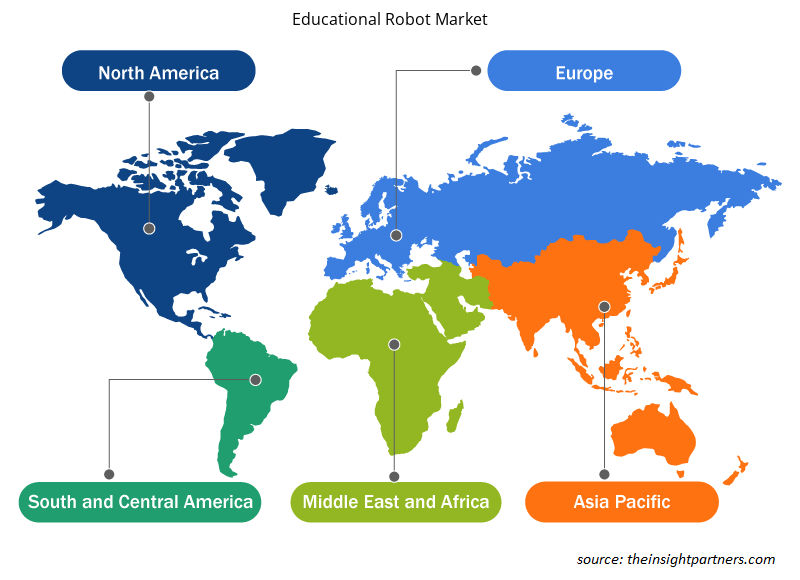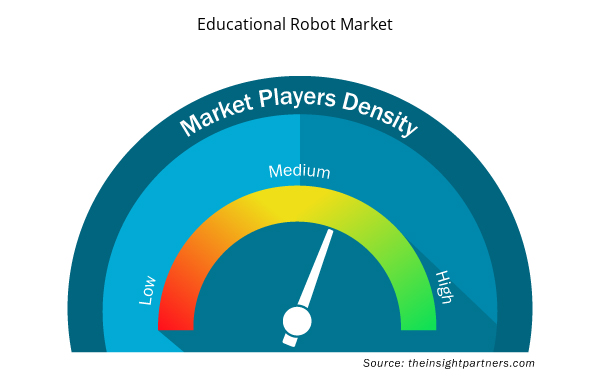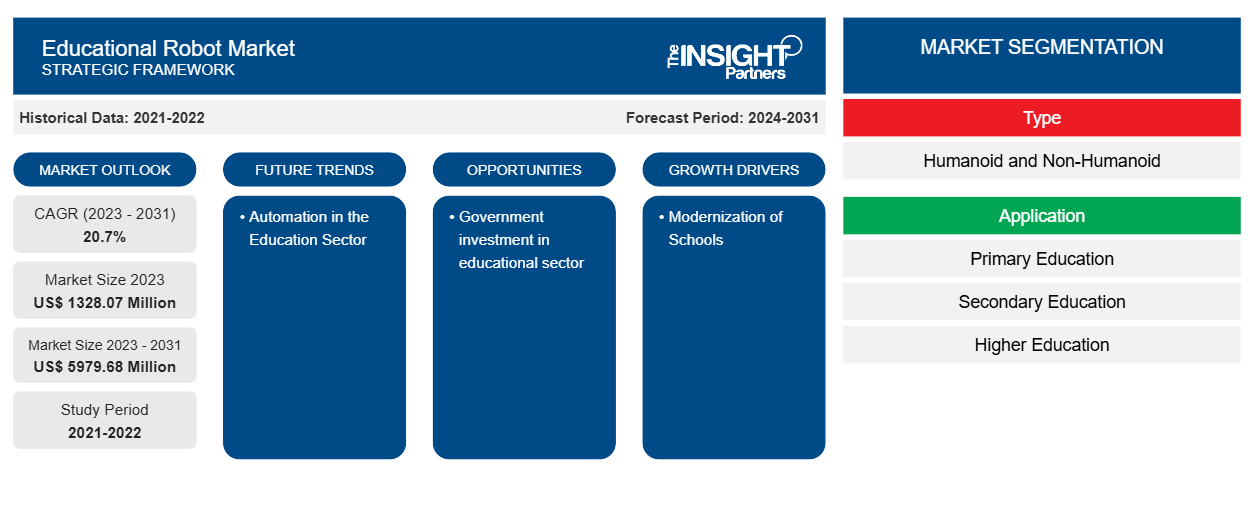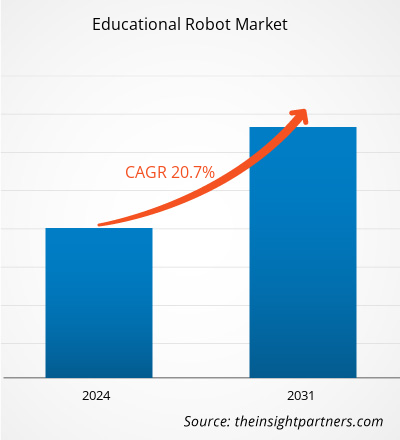Se proyecta que el mercado de robots educativos alcance los 5979,68 millones de dólares en 2031, frente a los 1328,07 millones de dólares en 2023. Se espera que el mercado registre una CAGR del 20,7 % durante el período 2023-2031. Es probable que la inversión gubernamental en robótica y automatización en el sector educativo siga siendo una tendencia clave en el mercado.CAGR of 20.7% during 2023–2031. The government investment in robotics and automation in the education sector are likely to remain key trends in the market.
Análisis del mercado de robots educativos
El creciente interés por mejorar la ciencia, la tecnología, la ingeniería y las matemáticas (STEM) está impulsando el crecimiento del mercado. Las inversiones en el sistema educativo por parte de las autoridades gubernamentales fomentan aún más el crecimiento del mercado. Las escuelas y universidades están incluyendo diversos aspectos de la robótica que impulsan el crecimiento del mercado.
Descripción general del mercado de robots educativos
Los robots educativos son robots programables que permiten a los estudiantes de todas las edades profundizar sus conocimientos de robótica y programación. Además, les ayuda a aprender otras habilidades cognitivas. Proporciona a los estudiantes todo lo que necesitan para construir y programar un robot que pueda realizar una variedad de tareas.
Personalice este informe según sus necesidades
Obtendrá personalización en cualquier informe, sin cargo, incluidas partes de este informe o análisis a nivel de país, paquete de datos de Excel, así como también grandes ofertas y descuentos para empresas emergentes y universidades.
- Obtenga las principales tendencias clave del mercado de este informe.Esta muestra GRATUITA incluirá análisis de datos, desde tendencias del mercado hasta estimaciones y pronósticos.
Factores impulsores y oportunidades del mercado de robots educativos
Modernización de las escuelas
El gobierno está invirtiendo fuertemente en el sector educativo para modernizar las escuelas y colegios y mejorar aún más el aprendizaje de los estudiantes. Estas inversiones están animando a los actores del mercado a proporcionar sus robots educativos en las escuelas, lo que está impulsando el crecimiento del mercado. Por ejemplo, en abril de 2022, Shape Robotics de Dinamarca dijo que había firmado un acuerdo con su homólogo local KUBO Robots para distribuir robots educativos a las escuelas de Rumania.
Automatización en el sector educativo
La encuesta global de ABB de 2023 a 2.301 profesionales de la educación descubrió que el 80 por ciento cree que los robots y la automatización darán forma al futuro del empleo en los próximos diez años. El uso de robots en el sistema educativo y los programas de enseñanza. Los actores del mercado de robots industriales se centran en el lanzamiento de robots en el sector educativo que puedan impulsar el mercado de robots educativos en el futuro.
Análisis de segmentación del informe de mercado de robots educativos
Los segmentos clave que contribuyeron a la derivación del análisis del mercado de robots educativos son el tipo y la aplicación.
- Según el tipo, el mercado de robots educativos se segmenta en humanoides y no humanoides. El segmento de los no humanoides tuvo la mayor participación del mercado en 2023.
- Por aplicación, el mercado se segmenta en educación primaria, educación secundaria, educación superior y otros. El otro segmento tenía una participación significativa del mercado en 2023.
Análisis de la cuota de mercado de robots educativos por geografía
El alcance geográfico del informe del mercado de robots educativos se divide principalmente en cinco regiones: América del Norte, Asia Pacífico, Europa, Medio Oriente y África, y América del Sur y Central.
Se espera que la región de Asia Pacífico crezca con la CAGR más alta durante el período de pronóstico. La región se centra en el avance tecnológico en el sector educativo. La creciente inversión en el sector educativo complementa el crecimiento del mercado. La introducción de robots en las escuelas impulsa aún más el crecimiento del mercado en la región. Por ejemplo, en marzo de 2024, una escuela de Kerala presentó a la primera maestra de inteligencia artificial del país, Iris, para dar un paso innovador hacia la educación. Iris se creó en asociación con Makerlabs Edutech y es el primer robot docente humanoide del estado y probablemente del país. Iris es capaz de responder consultas complejas sobre diversas materias, ofrecer asistencia de voz individualizada y promover oportunidades educativas interactivas. Además, Iris está equipada con ruedas para aumentar la movilidad.CAGR during the forecast period. The region is focused on technological advancement in the educational sector. The rising investment in the educational sector Kerala school introduced the country’s first AI Teacher, Iris to take an innovative step towards education. Iris was created in partnership with Makerlabs Edutech and is the state's and probably the nation's first humanoid robot teacher. Iris is capable of answering intricate queries across various subjects, offering individualized voice support, and promoting interactive educational opportunities. In addition, Iris is equipped with wheels to increase mobility.
Perspectivas regionales del mercado de robots educativos
Los analistas de Insight Partners explicaron en detalle las tendencias y los factores regionales que influyen en el mercado de robots educativos durante el período de pronóstico. Esta sección también analiza los segmentos y la geografía del mercado de robots educativos en América del Norte, Europa, Asia Pacífico, Oriente Medio y África, y América del Sur y Central.

- Obtenga datos regionales específicos para el mercado de robots educativos
Alcance del informe sobre el mercado de robots educativos
| Atributo del informe | Detalles |
|---|---|
| Tamaño del mercado en 2023 | US$ 1328,07 millones |
| Tamaño del mercado en 2031 | US$ 5979,68 millones |
| CAGR global (2023 - 2031) | 20,7% |
| Datos históricos | 2021-2022 |
| Período de pronóstico | 2024-2031 |
| Segmentos cubiertos | Por tipo
|
| Regiones y países cubiertos | América del norte
|
| Líderes del mercado y perfiles de empresas clave |
|
Densidad de actores del mercado de robots educativos: comprensión de su impacto en la dinámica empresarial
El mercado de robots educativos está creciendo rápidamente, impulsado por la creciente demanda de los usuarios finales debido a factores como la evolución de las preferencias de los consumidores, los avances tecnológicos y una mayor conciencia de los beneficios del producto. A medida que aumenta la demanda, las empresas amplían sus ofertas, innovan para satisfacer las necesidades de los consumidores y aprovechan las tendencias emergentes, lo que impulsa aún más el crecimiento del mercado.
La densidad de actores del mercado se refiere a la distribución de las empresas o firmas que operan dentro de un mercado o industria en particular. Indica cuántos competidores (actores del mercado) están presentes en un espacio de mercado determinado en relación con su tamaño o valor total de mercado.
Las principales empresas que operan en el mercado de robots educativos son:
- Robótica Aisoy
- Hanson Robotics Limited
- Robótica modular
- Robótica PAL
- Corporación FANUC América
- Tecnología de innovación Sanbot Ltd.
Descargo de responsabilidad : Las empresas enumeradas anteriormente no están clasificadas en ningún orden particular.

- Obtenga una descripción general de los principales actores clave del mercado de robots educativos
Noticias y desarrollos recientes del mercado de robots educativos
El mercado de robots educativos se evalúa mediante la recopilación de datos cualitativos y cuantitativos a partir de investigaciones primarias y secundarias, que incluyen publicaciones corporativas importantes, datos de asociaciones y bases de datos. A continuación, se enumeran algunos de los avances en el mercado de robots educativos:
- ABB Robotics ha ampliado su oferta educativa con el lanzamiento del IRB 1090. El robot educativo industrial 1090, autentificado por el instituto educativo STEM.org, reconocido mundialmente, está diseñado para mejorar las habilidades de los estudiantes y brindarles una ventaja competitiva para conseguir empleo. El nuevo robot educativo forma parte fundamental de la oferta educativa más amplia de ABB, que incluye robots industriales adicionales, así como paquetes educativos, controladores de última generación y software de simulación y programación líder en el mercado. (Fuente: ABB Robotics, nota de prensa, septiembre de 2023)
- MatataStudio, un proveedor de soluciones de aprendizaje digital con innovación y originalidad como ejes centrales, lanzó un nuevo kit de robot educativo llamado "VinciBot", con el objetivo de combinar informática, inteligencia artificial y educación de forma entretenida. Conceptos de alta tecnología como (IA) y aprendizaje automático (ML) se introducen en las aulas de la escuela primaria. Estos kits de robótica no solo son altamente educativos, sino que también incorporan programación, pensamiento computacional, creatividad y exploración. El concepto de diseño de MatataStudio es alentar a los niños a dominar los conocimientos básicos de programación y informática mediante la construcción y operación de robots con sus propias manos mientras cultivan su pensamiento innovador y sus habilidades para resolver problemas. (Fuente: MatataStudio, comunicado de prensa, febrero de 2024)
Cobertura y resultados del informe sobre el mercado de robots educativos
El informe "Tamaño y pronóstico del mercado de robots educativos (2021-2031)" proporciona un análisis detallado del mercado que cubre las siguientes áreas:
- Tamaño del mercado de robots educativos y pronóstico a nivel global, regional y nacional para todos los segmentos clave del mercado cubiertos bajo el alcance
- Tendencias del mercado de robots educativos, así como dinámicas del mercado, como impulsores, restricciones y oportunidades clave
- Análisis detallado de las cinco fuerzas de Porter y PEST y FODA
- Análisis del mercado de robots educativos que cubre las tendencias clave del mercado, el marco global y regional, los principales actores, las regulaciones y los desarrollos recientes del mercado
- Análisis del panorama de la industria y de la competencia que abarca la concentración del mercado, el análisis de mapas de calor, los actores destacados y los desarrollos recientes en el mercado de robots educativos
- Perfiles detallados de empresas
- Análisis histórico (2 años), año base, pronóstico (7 años) con CAGR
- Análisis PEST y FODA
- Tamaño del mercado Valor/volumen: global, regional, nacional
- Industria y panorama competitivo
- Conjunto de datos de Excel



Report Coverage
Revenue forecast, Company Analysis, Industry landscape, Growth factors, and Trends

Segment Covered
This text is related
to segments covered.

Regional Scope
North America, Europe, Asia Pacific, Middle East & Africa, South & Central America

Country Scope
This text is related
to country scope.
Preguntas frecuentes
The estimated value of the educational robot market will be US$ 5979.68 million by 2031.
Aisoy Robotics; Hanson Robotics Limited; Modular Robotics; PAL Robotics; FANUC America Corporation; Sanbot Innovation Technology Ltd.; Life & Science, Inc.; iRobot Education; Softbank Robotics Group Corp.; and Lego System A/S are some of the key players operating in the educational robot market.
The government investment in robotics and the need for cognitive skills in kids are the key driving factors impacting the educational robot market.
Automation in the education sector is considered a key trend in the online exam-proctoring market.
The global educational robot market is estimated to register a CAGR of 20.7% during the forecast period 2023–2031.
Trends and growth analysis reports related to Electronics and Semiconductor : READ MORE..
The Insight Partners performs research in 4 major stages: Data Collection & Secondary Research, Primary Research, Data Analysis and Data Triangulation & Final Review.
- Data Collection and Secondary Research:
As a market research and consulting firm operating from a decade, we have published and advised several client across the globe. First step for any study will start with an assessment of currently available data and insights from existing reports. Further, historical and current market information is collected from Investor Presentations, Annual Reports, SEC Filings, etc., and other information related to company’s performance and market positioning are gathered from Paid Databases (Factiva, Hoovers, and Reuters) and various other publications available in public domain.
Several associations trade associates, technical forums, institutes, societies and organization are accessed to gain technical as well as market related insights through their publications such as research papers, blogs and press releases related to the studies are referred to get cues about the market. Further, white papers, journals, magazines, and other news articles published in last 3 years are scrutinized and analyzed to understand the current market trends.
- Primary Research:
The primarily interview analysis comprise of data obtained from industry participants interview and answers to survey questions gathered by in-house primary team.
For primary research, interviews are conducted with industry experts/CEOs/Marketing Managers/VPs/Subject Matter Experts from both demand and supply side to get a 360-degree view of the market. The primary team conducts several interviews based on the complexity of the markets to understand the various market trends and dynamics which makes research more credible and precise.
A typical research interview fulfils the following functions:
- Provides first-hand information on the market size, market trends, growth trends, competitive landscape, and outlook
- Validates and strengthens in-house secondary research findings
- Develops the analysis team’s expertise and market understanding
Primary research involves email interactions and telephone interviews for each market, category, segment, and sub-segment across geographies. The participants who typically take part in such a process include, but are not limited to:
- Industry participants: VPs, business development managers, market intelligence managers and national sales managers
- Outside experts: Valuation experts, research analysts and key opinion leaders specializing in the electronics and semiconductor industry.
Below is the breakup of our primary respondents by company, designation, and region:

Once we receive the confirmation from primary research sources or primary respondents, we finalize the base year market estimation and forecast the data as per the macroeconomic and microeconomic factors assessed during data collection.
- Data Analysis:
Once data is validated through both secondary as well as primary respondents, we finalize the market estimations by hypothesis formulation and factor analysis at regional and country level.
- Macro-Economic Factor Analysis:
We analyse macroeconomic indicators such the gross domestic product (GDP), increase in the demand for goods and services across industries, technological advancement, regional economic growth, governmental policies, the influence of COVID-19, PEST analysis, and other aspects. This analysis aids in setting benchmarks for various nations/regions and approximating market splits. Additionally, the general trend of the aforementioned components aid in determining the market's development possibilities.
- Country Level Data:
Various factors that are especially aligned to the country are taken into account to determine the market size for a certain area and country, including the presence of vendors, such as headquarters and offices, the country's GDP, demand patterns, and industry growth. To comprehend the market dynamics for the nation, a number of growth variables, inhibitors, application areas, and current market trends are researched. The aforementioned elements aid in determining the country's overall market's growth potential.
- Company Profile:
The “Table of Contents” is formulated by listing and analyzing more than 25 - 30 companies operating in the market ecosystem across geographies. However, we profile only 10 companies as a standard practice in our syndicate reports. These 10 companies comprise leading, emerging, and regional players. Nonetheless, our analysis is not restricted to the 10 listed companies, we also analyze other companies present in the market to develop a holistic view and understand the prevailing trends. The “Company Profiles” section in the report covers key facts, business description, products & services, financial information, SWOT analysis, and key developments. The financial information presented is extracted from the annual reports and official documents of the publicly listed companies. Upon collecting the information for the sections of respective companies, we verify them via various primary sources and then compile the data in respective company profiles. The company level information helps us in deriving the base number as well as in forecasting the market size.
- Developing Base Number:
Aggregation of sales statistics (2020-2022) and macro-economic factor, and other secondary and primary research insights are utilized to arrive at base number and related market shares for 2022. The data gaps are identified in this step and relevant market data is analyzed, collected from paid primary interviews or databases. On finalizing the base year market size, forecasts are developed on the basis of macro-economic, industry and market growth factors and company level analysis.
- Data Triangulation and Final Review:
The market findings and base year market size calculations are validated from supply as well as demand side. Demand side validations are based on macro-economic factor analysis and benchmarks for respective regions and countries. In case of supply side validations, revenues of major companies are estimated (in case not available) based on industry benchmark, approximate number of employees, product portfolio, and primary interviews revenues are gathered. Further revenue from target product/service segment is assessed to avoid overshooting of market statistics. In case of heavy deviations between supply and demand side values, all thes steps are repeated to achieve synchronization.
We follow an iterative model, wherein we share our research findings with Subject Matter Experts (SME’s) and Key Opinion Leaders (KOLs) until consensus view of the market is not formulated – this model negates any drastic deviation in the opinions of experts. Only validated and universally acceptable research findings are quoted in our reports.
We have important check points that we use to validate our research findings – which we call – data triangulation, where we validate the information, we generate from secondary sources with primary interviews and then we re-validate with our internal data bases and Subject matter experts. This comprehensive model enables us to deliver high quality, reliable data in shortest possible time.


 Obtenga una muestra gratuita de este informe
Obtenga una muestra gratuita de este informe